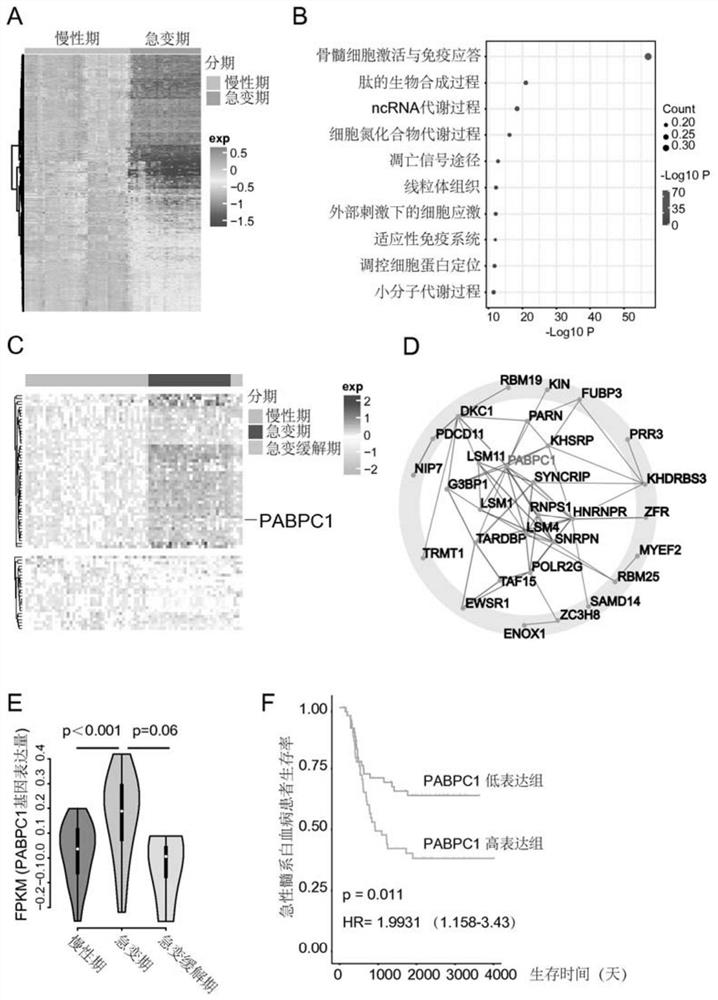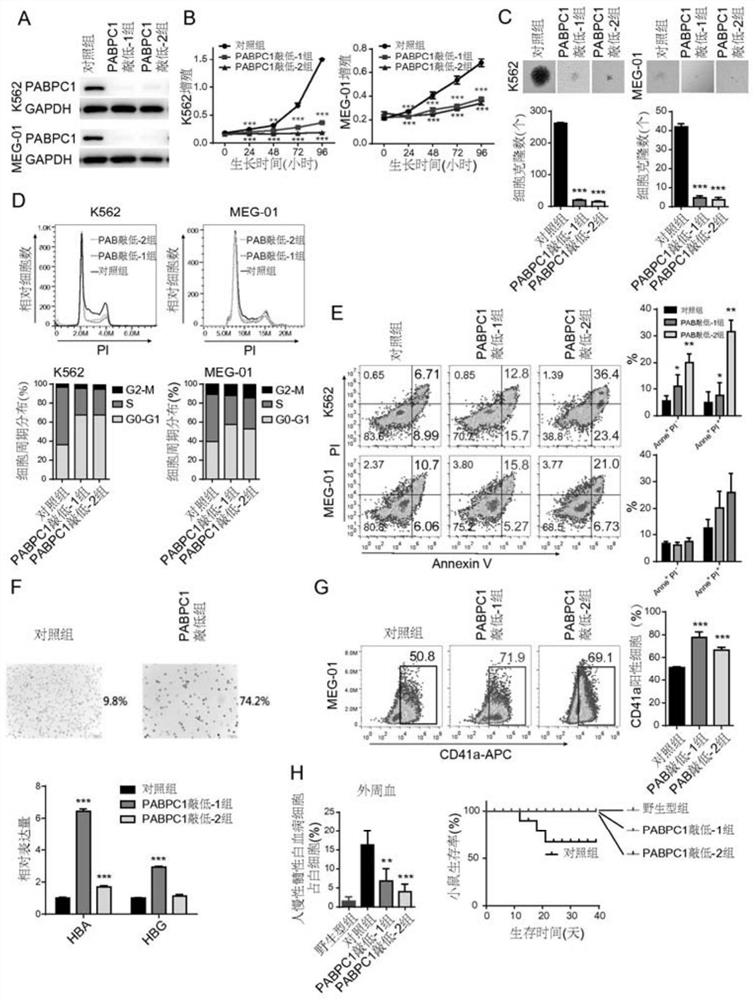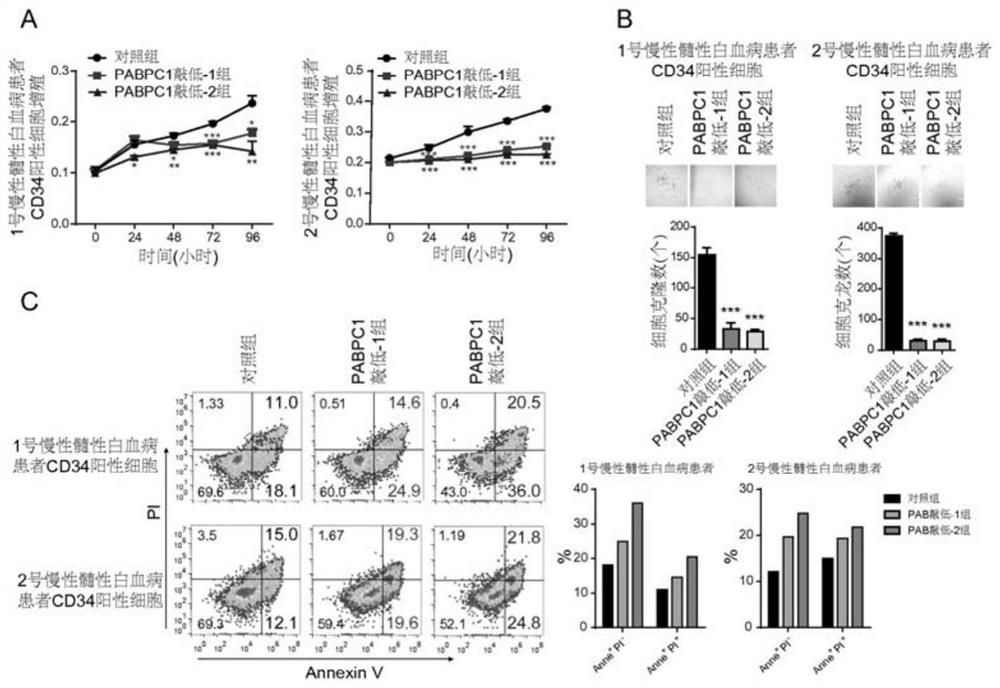Target PABPC1 related to leukemia diagnosis and treatment and application thereof
A technology for leukemia and leukemia cells, applied in the biological field, can solve the problems of leukemia without functional mechanism and few functional reports.
- Summary
- Abstract
- Description
- Claims
- Application Information
AI Technical Summary
Problems solved by technology
Method used
Image
Examples
Embodiment 1
[0065] Example 1, the expression of PABPC1 increases in the process of CML blast
[0066] 1. The expression of PABPC1 increases in the process of CML blast
[0067] 1. Analysis of the differential expression of genes in the blast process of CML patients
[0068] Reference [Proc Natl Acad Sci U S A.2006Feb 21; 103(8):2794-9.], 57 cases of CML patients in chronic phase and 33 cases of CML patients in blast phase were analyzed for gene differential expression, and the top 1000 significant differences were selected Expressed genes are visualized in Heatmap. The result is as figure 1 As shown in A, the results show that the expression levels of a series of genes are significantly up-regulated and down-regulated during the blast transition from chronic phase to blast phase in CML.
[0069]2. GO function enrichment analysis
[0070] GO function enrichment analysis was performed on the genes that were differentially changed during the blast mutation process, and the Bubble chart w...
Embodiment 2
[0084] Example 2, PABPC1 promotes the occurrence and development of CML disease in vivo and in vitro
[0085] 1. Preparation of PABPC1-knockdown CML blast phase cell lines K562 and MEG-01
[0086] 1. Construction of lentiviral recombinant plasmid
[0087] (1) Preparation of recombinant plasmid
[0088] Design and synthesize shPABPC1-1 specifically targeting PABPC1, its coding sequence is as follows:
[0089] CCAGACCTCATCCATTCCAAACTCGAGTTTGGAATGGATGAGGTCTGG (SEQ ID NO: 1).
[0090] Design and synthesize specific shPABPC1-5 targeting PABPC1, its coding sequence is as follows:
[0091] AGCTGTTCCAACCCTGTAATCTCGAGATTACAGGGTTGGGAACAGC (SEQ ID NO: 2).
[0092] The above shRNA coding sequences were cloned into pLKO.1 lentiviral plasmid (Addgene) to obtain recombinant plasmids shPABPC1-1 and shPABPC1-2, respectively.
[0093] (2) Identification of recombinant plasmids
[0094] The recombinant plasmids were identified by PCR, and the correct recombinant plasmids identified by PCR ...
Embodiment 3
[0173] Example 3. Substances that inhibit the expression of PABPC1 can inhibit the proliferation of hematopoietic stem / progenitor cells in CML patients
[0174] 1. Separation and culture of bone marrow cells from CML patients CD34+ cells
[0175] Bone marrow CD34-positive cells were isolated and cultured from two patients with newly diagnosed CML (respectively denoted as chronic myelogenous leukemia patient No. 1 and chronic myelogenous leukemia patient No. 2), and the specific steps were as follows:
[0176] 1. Reagent preparation: sorting buffer (PBS, 2% FBS, 0.4% 0.5M EDTA, 1% double antibody), cell sorting-magnetic beads CD34 + (Miltenyi, 130-046-702), magnetic rack (Miltenyi), HISTOPAQUE-1077 (Sigma, 10771), serum-free cell freezing medium (ZENOAQ, Cell Banker 2-100).
[0177] 2. Separation of bone marrow single cells from CML patients: Dilute the bone marrow blood sample of CML patients with 4 times the volume of EDTA-PBS, carefully add it to Ficoll with a volume of 0.5...
PUM
 Login to View More
Login to View More Abstract
Description
Claims
Application Information
 Login to View More
Login to View More - R&D
- Intellectual Property
- Life Sciences
- Materials
- Tech Scout
- Unparalleled Data Quality
- Higher Quality Content
- 60% Fewer Hallucinations
Browse by: Latest US Patents, China's latest patents, Technical Efficacy Thesaurus, Application Domain, Technology Topic, Popular Technical Reports.
© 2025 PatSnap. All rights reserved.Legal|Privacy policy|Modern Slavery Act Transparency Statement|Sitemap|About US| Contact US: help@patsnap.com



